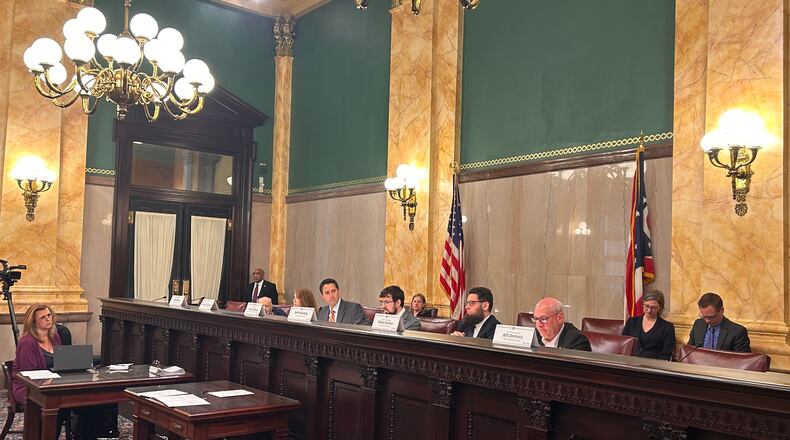The proposed amendment to be voted on Aug. 8 would:
- Require that any proposed amendment to the Ohio Constitution get at least 60% of votes (raising that threshold from a simple majority).
- Require that any petition for an amendment to be put in front of voters be signed by at least 5% of the eligible voters in each of Ohio’s 88 counties (raising that from 44 counties). That would begin in 2024.
- Specify that additional signatures can not be added to a filed petition (now additions are allowed for 10 days after filing).
The current rules have been in place since Ohio adopted the citizen-initiated constitutional amendment process in 1912.
The ballot language was set in a Thursday morning Ohio Ballot Board meeting where Secretary of State Frank LaRose and two representatives each from both parties heard public comment and debated. The language was passed 3-2 on party lines with LaRose and other Republicans in the majority.
The meeting followed last week’s final passage of Senate Joint Resolution 2, which, throughout its legislative process, brought opposition testimony from individuals and groups across the state, public protests to the statehouse, unanimous dissent from Democrat lawmakers and splintered support from the Ohio House’s GOP supermajority.
Complaints about wording
In public testimony Thursday, Don McTigue of One Person One Vote argued that the adopted description of Issue 1 does not highlight the actual changes it would bring.
“It does not inform voters, in any way, what the change is from current law,” he said, later highlighting how important he believes it is to tell voters how long current law has been in practice.
McTigue also argued that “elevate the standards” — from the concise description, “Elevating the standards to qualify for and to pass any constitutional amendment.” — is a loaded term that would sway the average voter. More correct, McTigue argued, would be “modify” or “change” the standards.
Board members Sen. Bill DeMora, D-Columbus, and Rep. Elliott Forhan, D-Youngstown, said the language on the ballot misrepresents how many signatures would need to be gathered by canvassers. The resolution actually requires canvassers to gather signatures from 5% of eligible voters who voted in the last gubernatorial election — not 5% of all registered voters.
LaRose told reporters that it was his goal to explain the proposed amendment in as few words as possible.
“The actual amendment is available for people to read. The argument for and against (will be) available for people to read,” LaRose said. “Putting a ton of words on the actual ballot is confusing to people in and of itself.”
The ballot language is not legally binding, DeMora said after the meeting concluded, but said, “it’s misleading to the voters.”
No amendments were made and the ballot language was approved by a 3-2 vote. LaRose joined SJR2 primary sponsor Sen. Theresa Gavarone and a Republican board appointee Bill Morgan in approval. LaRose later told reporters that elevate is a correct word to use based on its denotation.
The ballot will also include an explanation for Issue 1, approved by the same 3-2 vote.
Here’s the full explanation:
Issue 1 asks eligible Ohio voters to consider an amendment to the Constitution of the State of Ohio proposed by a two-thirds majority of the Ohio General Assembly. The amendment, if approved, would elevate the standards by which the Constitution of the State of Ohio may be amended. Any newly proposed constitutional amendment placed on a statewide ballot must receive at least 60 percent of the vote to be approved. Any initiated petition proposing to amend the Constitution of the State of Ohio that is filed with the Secretary of State on or after January 1, 2024 must contain the signatures of at least five percent of the eligible voters resident in each county of the state. Finally, the amendment specifies that new signatures may not be added to an initiative petition proposing to amend the Constitution of the State of Ohio once it has been filed with the Secretary of State on or after January 1, 2024.
About the Author

